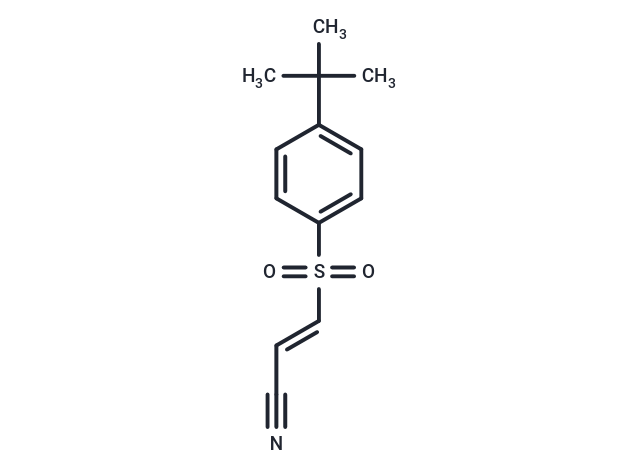Shopping Cart
- Remove All
 Your shopping cart is currently empty
Your shopping cart is currently empty

Bay 11-7085 can irreversibly inhibit the IκBα phosphorylation induced by TNFα (IC50: 10 μM).

| Pack Size | Price | Availability | Quantity |
|---|---|---|---|
| 2 mg | $30 | In Stock | |
| 5 mg | $43 | In Stock | |
| 10 mg | $61 | In Stock | |
| 25 mg | $77 | In Stock | |
| 50 mg | $126 | In Stock | |
| 100 mg | $207 | In Stock | |
| 200 mg | $269 | In Stock | |
| 1 mL x 10 mM (in DMSO) | $56 | In Stock |
| Description | Bay 11-7085 can irreversibly inhibit the IκBα phosphorylation induced by TNFα (IC50: 10 μM). |
| Targets&IC50 | IκBα phosphorylation:10 μM |
| In vitro | In athymic nude mice harboring Caov-3 cells, BAY 11-7085 enhances the inhibitory effect of paclitaxel on intraperitoneal spread and ascites formation. Additionally, BAY 11-7085 suppresses the increase in NF-κB activity associated with meningitis, improves the clinical condition of infected rats, and significantly reduces CNS complications and inflammation related to meningitis. |
| In vivo | When used in conjunction with paclitaxel, BAY 11-7085 enhances the inhibition of NF-κB activity and reduces the survival rate of paclitaxel-treated cells. By inhibiting NF-κB, BAY 11-7085 suppresses the expression of the adhesion molecules E-selectin, ICAM-1, and VCAM-1 induced by TNFα. BAY 11-7085 (10 μM) exhibits no cytotoxicity towards HUVEC cells. Moreover, the combined use of BAY 11-7085 and LY294002 synergistically influences apoptosis in PEL cells. |
| Kinase Assay | In Gel Kinase Assay: In gel kinase assay for the proteins that phosphorylate IκB-α is carried out as detailed below. Whole cell extracts are prepared from HUVEC treated with TNFα (100 units/ml) for 15 min in the presence or absence of inhibitor (20 μM, pretreatment for 1 h) as indicated. Proteins are separated on a 10% SDS gel containing 0.5 mg/ml HIS-IκB-α. Gels are washed two times in 20% propanol, 50 mM Hepes, pH 7.6, for 30 min and two times in buffer A (50 mM Hepes, pH 7.6, 5 mM 2-mercaptoethanol) for 30 min, followed by a 1-h incubation with buffer A containing 6 M urea, 1 h each in 3, 1.5, and 0.75 M urea in buffer A and 0.05% Tween 20 and 1 h in buffer A with 0.05% Tween 20. The kinase assay is carried out for 1 h at 30?°C in the presence of 50 μM ATP, 5 μCi/ml [32P]ATP, 20 mM Hepes, pH 7.6, 20 mM MgCl2, 20 mM β-glycerophosphate, 20 mM p-nitrophenyl phosphate, 1 mM sodium vanadate, 2 mM dithiothreitol. The gel is washed with 5% trichloroacetic acid and 1% sodium pyrophosphate, dried, and exposed to film. A separate gel with no HIS-IκB-α is assayed as a control. |
| Cell Research | Human umbilical vein endothelial cells (HUVEC) are isolated and maintained in culture. Cell toxicity is assessed by morphology and by MTT assay.(Only for Reference) |
| Alias | BAY 11-7083 |
| Molecular Weight | 249.33 |
| Formula | C13H15NO2S |
| Cas No. | 196309-76-9 |
| Smiles | CC(C)(C)c1ccc(cc1)S(=O)(=O)\C=C\C#N |
| Relative Density. | 1.144g/cm3 |
| Storage | Powder: -20°C for 3 years | In solvent: -80°C for 1 year | Shipping with blue ice. | ||||||||||||||||||||||||||||||
| Solubility Information | DMSO: 24.9 mg/mL (99.87 mM), Sonication is recommended. Ethanol: 24.9 mg/mL (99.87 mM), Sonication is recommended. | ||||||||||||||||||||||||||||||
Solution Preparation Table | |||||||||||||||||||||||||||||||
DMSO/Ethanol
| |||||||||||||||||||||||||||||||

Copyright © 2015-2025 TargetMol Chemicals Inc. All Rights Reserved.